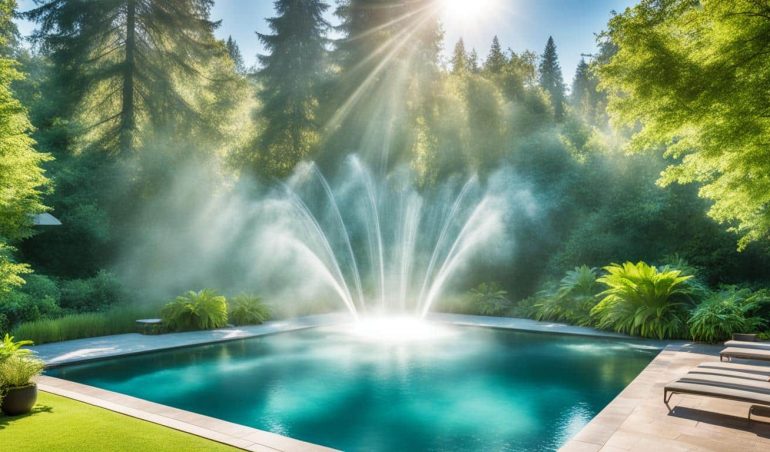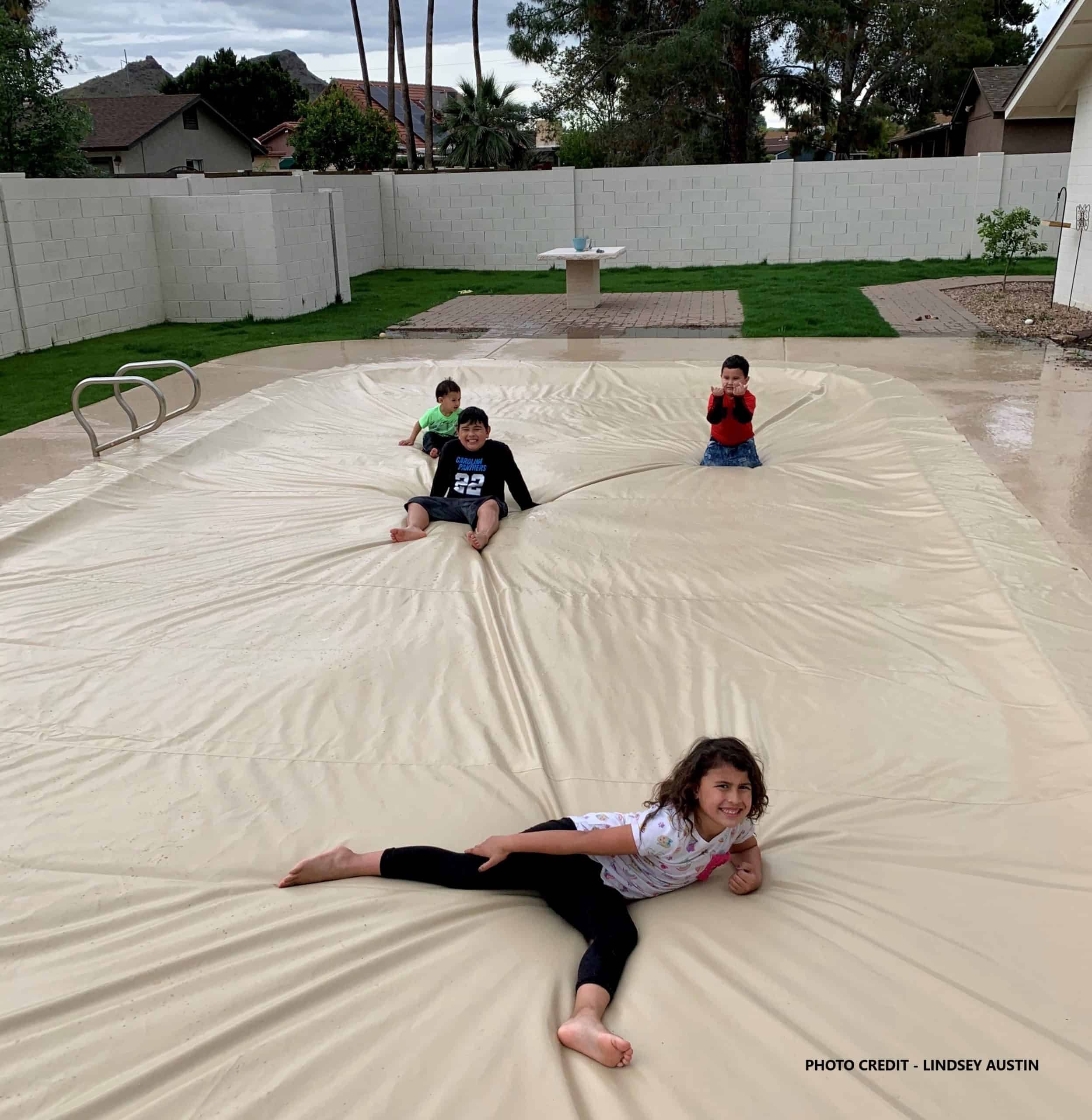When it comes to optimizing your pool experience, thermal pool covers have become an increasingly popular choice among pool owners. These covers offer a range of potential benefits, from energy savings and reduced maintenance to extended swimming sessions. But amidst the myriad options available, one question lingers: Are thermal pool covers really worth the investment?
Before diving into the details, let’s explore the value that thermal pool covers can bring to your pool and your pocket. By understanding the advantages and potential drawbacks, you can make an informed decision about whether thermal pool covers are the right choice for you.
Key Takeaways:
- Thermal pool covers offer the potential for energy savings and reduced maintenance.
- They can help extend your swimming season and improve overall pool experience.
- Thermal pool covers act as an insulation layer and reduce heat loss through evaporation.
- Different types of thermal pool covers offer varying levels of effectiveness and durability.
- Consider practical aspects such as installation, maintenance, and safety when using thermal pool covers.
The Impact of Thermal Pool Covers on Heating Costs
When it comes to heating costs, thermal pool covers can make a significant difference. These covers are designed to help pool owners save energy and reduce expenses by minimizing heat loss and maximizing energy efficiency.
By placing a thermal pool cover over the water surface, the pool is protected from heat loss due to evaporation, which is a major factor in high heating costs. Research and studies have shown that thermal pool covers can help reduce evaporation by up to 95%, resulting in substantial energy savings and cost reductions.
Not only do thermal pool covers reduce heat loss through evaporation, but they also act as insulation for the pool. The cover prevents the dissipation of heat and keeps the water temperature stable, reducing the need for consistent heating and further contributing to energy efficiency. This insulation property allows pool owners to enjoy longer swimming sessions without worrying about significant heat loss.
The cost savings associated with using thermal pool covers can be significant over time. By decreasing heat loss, pool owners can reduce the frequency and duration of heating cycles, resulting in lower energy consumption. This translates into substantial cost savings on utility bills.
In addition to the direct savings on heating costs, thermal pool covers can also lead to savings in maintenance expenses. The covers help keep the pool water clean and reduce the need for chemical treatments, filtration, and cleaning, saving both time and money.
In summary, thermal pool covers have a positive impact on heating costs by reducing heat loss through evaporation, acting as insulation, and providing significant energy savings and cost reductions. Investing in a high-quality thermal pool cover can result in long-term cost savings, improved energy efficiency, and enhanced enjoyment of the pool throughout the year.
How Thermal Pool Covers Work to Save Energy
Thermal pool covers are a smart investment for any pool owner looking to reduce energy consumption and cut costs. These covers work by employing unique mechanisms that minimize heat loss and ensure energy efficiency. Understanding how thermal pool covers save energy can help pool owners make informed decisions about their usage.
One of the primary ways thermal pool covers contribute to energy savings is by reducing evaporation. Evaporation is a natural process that causes pools to lose substantial amounts of heat. A thermal pool cover acts as a barrier, preventing water from escaping into the atmosphere and thus minimizing heat loss due to evaporation. By keeping the pool water covered, thermal pool covers can significantly reduce the energy required to maintain the pool at a comfortable temperature.
In addition to reducing evaporation, thermal pool covers also provide insulation for the pool. These covers are designed with materials that have excellent heat retention properties. When the pool is covered, the thermal pool cover acts as a layer of insulation, trapping heat inside the pool and preventing it from escaping. This insulation effect helps to maintain the water temperature and reduces the need for excessive heating, resulting in significant energy savings.
The energy savings achieved with thermal pool covers can be quite impressive. Studies have shown that by using a thermal pool cover, pool owners can reduce energy consumption by up to 70%. This translates to substantial cost savings on heating bills. Furthermore, the reduced heat loss through evaporation also means reduced water use, making thermal pool covers an environmentally friendly choice.
Investing in a high-quality thermal pool cover is a practical step towards energy efficiency and cost savings. By reducing evaporation and providing insulation, these covers play a vital role in preserving heat and maintaining the pool temperature. The resulting energy savings contribute not only to lower utility bills but also to a more sustainable approach to pool ownership.
Types of Thermal Pool Covers and Their Effectiveness
When it comes to thermal pool covers, there are various types available in the market, each with its own set of benefits and drawbacks. Understanding the different options can help pool owners make an informed decision based on their specific needs and preferences.
Solar Covers: Solar covers are designed to harness the power of the sun to heat the pool water. These covers are made of a durable, UV-resistant material that helps retain heat and prevent evaporation. They can effectively increase water temperature and reduce energy costs by minimizing heat loss. Solar covers are often available in various sizes to fit different pool shapes and sizes.
Solar Blankets: Similar to solar covers, solar blankets are also designed to utilize solar energy for heating the pool. These blankets are typically thicker and heavier than solar covers, providing better insulation and heat retention. Some solar blankets have a bubble wrap-like texture that enhances their ability to trap warmth. They are easy to install and remove, making them a convenient option for pool owners.
Liquid Solar Covers: Liquid solar covers are a relatively newer innovation in pool cover technology. These covers consist of a liquid solution that forms a thin, transparent layer on the water surface. This layer acts as a barrier, reducing evaporation and heat loss. Liquid solar covers are easy to use, as they can simply be poured into the pool. However, they may require regular reapplication to maintain their effectiveness.
When considering the effectiveness of each type of thermal pool cover, it is important to consider factors such as durability, heat retention, and ease of use. Solar covers and solar blankets are known for their durability and ability to retain heat. They are also relatively easy to use, with options for manual, semi-automatic, and automatic reels for convenient installation and removal. On the other hand, liquid solar covers offer ease of use but may require frequent reapplication to maintain their effectiveness.
Choosing the most suitable thermal pool cover depends on individual needs and preferences. Solar covers and solar blankets are ideal for pool owners who want a long-lasting and efficient solution for heating their pools. Liquid solar covers, on the other hand, are a convenient option for those who prefer a more low-maintenance approach. Ultimately, it is recommended to consider the specific requirements of your pool along with the pros and cons of each type before making a decision.
| Type of Cover | Durability | Heat Retention | Ease of Use |
|—————–|————|—————-|————–|
| Solar Covers | High | High | Moderate |
| Solar Blankets | High | High | Easy |
| Liquid Solar Covers | Low | Moderate | Easy |
*Note: Durability, heat retention, and ease of use are assessed based on average user experience and industry standards.*
Practical Considerations in the Use of Pool Covers
When it comes to utilizing thermal pool covers, there are several practical considerations that pool owners should keep in mind. These considerations include the installation process, maintenance requirements, and safety precautions. By addressing these factors, pool owners can ensure optimal performance and longevity of their thermal pool covers.
Installation
Proper installation is crucial for the effective use of thermal pool covers. Pool owners should carefully follow the manufacturer’s instructions to ensure a secure and snug fit. Depending on the type of cover, additional equipment such as rollers or reels may be required for easy installation and removal. Investing time and effort into proper installation will help maximize the benefits provided by thermal pool covers.
Maintenance
Maintaining thermal pool covers is essential to their longevity and effectiveness. Regular cleaning and proper storage will help prevent the accumulation of dirt, debris, and algae. Pool owners should use mild cleaning agents and avoid harsh chemicals that could damage the cover material. It is also important to inspect the cover for any signs of wear or damage and address them promptly to avoid compromising its performance.
Safety
Safety considerations are paramount when using thermal pool covers, especially in households with children or pets. Pool owners should ensure that their thermal covers meet relevant safety standards and regulations. Additionally, it is important to educate family members and guests about the potential hazards associated with uncovered pools. Proper safety precautions, such as installing pool fences or alarms, can further enhance pool safety when using thermal covers.
| Practical Considerations | Description |
|---|---|
| Installation | Follow manufacturer’s instructions for proper fit. Use rollers or reels for easy installation and removal. |
| Maintenance | Regular cleaning using mild agents. Inspect for wear or damage and address promptly. |
| Safety | Ensure compliance with safety standards. Educate users about pool hazards. Consider additional safety measures. |
Are Thermal Pool Covers Worth It? An Analysis of Pros and Cons
When considering whether to invest in thermal pool covers, it’s important to weigh the pros and cons to make an informed decision. Thermal pool covers offer several benefits that can enhance the swimming experience and save energy, but there are also some drawbacks to consider.
Benefits of Thermal Pool Covers:
- Energy savings: Thermal pool covers help to retain heat and prevent evaporation, resulting in reduced heating costs and energy consumption.
- Reduced maintenance: By keeping debris out of the pool, thermal covers can reduce the need for cleaning and chemical treatments, saving both time and money.
- Prolonged swimming season: With the added insulation provided by thermal covers, pool owners can enjoy swimming sessions for a longer period, even during cooler months.
Drawbacks of Thermal Pool Covers:
- Cost: Depending on the type and material, thermal pool covers can have a significant upfront cost, which may require a considerable investment.
- Durability: Some thermal pool covers may have a shorter lifespan and require replacement or repair over time, adding to the overall cost.
- Potential safety issues: Thick thermal covers can pose a risk, especially if not correctly secured or if there are children or pets around the pool.
Despite these drawbacks, the cost-effectiveness of thermal pool covers should be considered. While there is an upfront expense, the long-term energy savings and reduced maintenance costs can make them a worthwhile investment. Pool owners should carefully assess their specific needs, budget, and safety concerns before deciding whether thermal pool covers are the right choice for their swimming pool.
Conclusion
In conclusion, thermal pool covers offer significant value to pool owners in terms of energy savings, reduced maintenance, and extended swimming sessions. Throughout this article, we have explored the various benefits and considerations of using thermal pool covers.
By reducing heat loss and evaporation, thermal pool covers contribute to energy savings and lower heating costs. They act as insulation, helping to retain heat in the pool and prolonging the swimming season. Additionally, thermal pool covers reduce debris and chemical evaporation, resulting in reduced maintenance and chemical usage.
While the initial investment in a thermal pool cover may seem substantial, the long-term cost-effectiveness cannot be overlooked. The potential savings in energy bills and maintenance expenses are significant factors to consider. Taking into account the value and benefits provided, it is clear that thermal pool covers are indeed worth the investment for pool owners.
If you are a pool owner concerned about energy efficiency, reduced maintenance, and maximizing the use of your pool, we highly recommend considering a thermal pool cover. Not only will it help you save on heating costs and chemical usage, but it will also enhance your swimming experience and contribute to a more sustainable lifestyle. Invest in a thermal pool cover today and enjoy the many advantages it brings to your pool!
In Phoenix or Tucson, AZ and want a quote on a Thermal Pool Cover? Contact our team at Solar Safe Pool Cover for a Free Quote.
FAQ
Are thermal pool covers worth the investment?
Thermal pool covers are definitely worth the investment. They provide numerous benefits, including energy savings, reduced maintenance, and extended swimming sessions.
How do thermal pool covers help reduce heating costs?
Thermal pool covers help reduce heating costs by minimizing heat loss and increasing energy efficiency. They act as insulation and prevent evaporation, which is a major source of heat loss in pools.
Is there any evidence to support the cost savings associated with using thermal pool covers?
Yes, there have been several research studies that demonstrate the significant cost savings achieved by using thermal pool covers. These studies show that pool owners can save a substantial amount of money on heating costs by investing in a thermal pool cover.
How do thermal pool covers save energy?
Thermal pool covers save energy by reducing heat loss through evaporation. They act as a barrier that prevents warm water from escaping the pool, resulting in less energy needed to maintain the desired temperature.
What types of thermal pool covers are available in the market?
There are several types of thermal pool covers available, including solar covers, solar blankets, and liquid solar covers.
How effective are the different types of thermal pool covers?
The effectiveness of each type of thermal pool cover varies. Solar covers and solar blankets are highly effective in reducing heat loss and evaporation, while liquid solar covers provide a thin layer of insulation. However, the choice of the most suitable type depends on individual preferences and needs.
What are the practical considerations when using thermal pool covers?
When using thermal pool covers, it is important to consider aspects such as installation, maintenance, and safety. Pool owners should ensure they have the necessary equipment, such as rollers or reels, for easy cover handling. Regular cleaning and proper maintenance are also essential to keep the thermal pool cover in good condition. Additionally, safety precautions should be taken, especially for households with children or pets.
What are the pros and cons of using thermal pool covers?
Thermal pool covers offer numerous benefits, such as energy savings, reduced maintenance, and prolonged swimming seasons. However, there are also some drawbacks to consider, including the initial cost of the cover, durability, and potential safety concerns. It’s important to weigh these pros and cons to make an informed decision.






